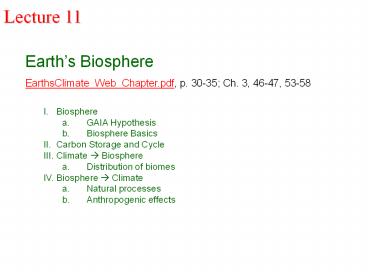Ecosystem Impacts of Climate Change - PowerPoint PPT Presentation
Title:
Ecosystem Impacts of Climate Change
Description:
GAIA: A New Look at Life on Earth ' ... GAIA forming and regulating atmosphere? 'An awesome thought came to me. ... Lovelock's GAIA Contribution ... – PowerPoint PPT presentation
Number of Views:62
Avg rating:3.0/5.0
Title: Ecosystem Impacts of Climate Change
1
Lecture 11
- Earths Biosphere
- EarthsClimate_Web_Chapter.pdf, p. 30-35 Ch. 3,
46-47, 53-58 - I. Biosphere
- GAIA Hypothesis
- Biosphere Basics
- II. Carbon Storage and Cycle
- III. Climate ? Biosphere
- Distribution of biomes
- IV. Biosphere ? Climate
- Natural processes
- Anthropogenic effects
2
Biosphere Life Processes on Earth
Reading P121-153
Atmosphere
Organic parts on Earth
Physical parts on Earth
Biosphere
Lithosphere Cryosphere
Hydrosphere
3
Whats driving Earths thermostat?
Globally averaged surface temperature today
59F (15C)
Over the last 300 million yrs, Earths surface
temperature varies just above or below the
freezing point of water, hence habitable to life.
4
GAIA A New Look at Life on Earth
. . . the physical and chemical condition of the
surface of the Earth, of the atmosphere, and of
the oceans has been and is actively made fit and
comfortable by the presence of life itself. This
is in contrast to the conventional wisdom which
held that life adapted to the planetary
conditions as it and they evolved their separate
ways. James Lovelock, 1979
5
GAIA forming and regulating atmosphere?
An awesome thought came to me. The Earths
atmosphere was an extraordinary and unstable
mixture of gases, yet I knew that it was constant
in composition over quite long periods of time.
Could it be that life on Earth not only made the
atmosphere, but also regulated it keeping it at
a constant composition, and at a level favorable
for organisms? James Lovelock, 1991
6
Lovelocks GAIA Contribution
Whether or not you accept the extreme versions of
the GAIA hypothesis, the publication of GAIA, A
New Look at Life on Earth (1979) has influenced
the way in which scientists and the general
public view the Earth. It is still being hotly
debated 25 years later. Raised consciousness!
Holistic view of the Earth. Earth from
space. Focused attention on the role of the
Biosphere in Atmospheric processes Promoted
interdisciplinary research (now strongly
supported by NCAR) Stimulated research to
prove/disprove GAIAN regulatory
mechanisms Fostered a systems approach to Earth
Science in which the Earth is viewed as a complex
system, with biogeochemical cycling between
Geosphere, Hydrosphere, Biosphere and Atmosphere
with important interactions and feedbacks between
them
7
(No Transcript)
8
(No Transcript)
9
Vertical Dimension of Biosphere
Most life lives in the zone 200 meters below sea
level and 6000 meters above sea level.
10
Biosphere Dynamics
- A. Ecosystems
- 1. Habitat - where an organism lives, its
environment - 2. Niche - interactions of an organism with its
habitat - 3. Ecosystem - habitat, niche and interactions
between organisms - B. Energy
- 1. Sun ? plants ? animals
- 2. First Law of Thermodynamics ? energy cannot
be destroyed or created, just changes form - C. Water cycle
- D. Nutrients and minerals recycled
- 1. Most plants require 17 elements
- Composition of life (95) is Carbon, Oxygen,
Hydrogen, Nitrogen, Phosphorous, and Sulfur. - 2. Elements and minerals necessary for animal
functions - E. Food chain (phytoplankton ? copepod ? fish ?
squid ? seal ? Orca ) - F. The biosphere pyramid (equilibrium balance /
sustainable ecosystem)
11
Earth Biomes
- A. Groups of ecosystems within a geographic
region exposed to the same physical conditions
with similar ecosystem structure. - Terrestrial biomes
- polar ice
- tundra
- temperate (boreal, coniferous, deciduous)
forests - grasslands
- deserts
- savanna
- tropical rain forests
- Aquatic biomes
- 1. Freshwater (e.g., lakes, rivers, swamps)
- 2. Marine (e.g., oceans)
- a. Coral reefs are the marine equivalent of the
tropical rain forests - b. Continental shelves vs. open ocean
- 3. Estuaries (transitional between fresh and
marine waters)
12
Todays Lecture Outline
- Earths Biosphere
- EarthsClimate_Web_Chapter.pdf, p. 30-35 Ch. 3,
46-47, 53-58 - I. Biosphere
- GAIA Hypothesis
- Biosphere Basics
- II. Carbon Storage and Cycle
- III. Climate ? Biosphere
- Distribution of biomes
- IV. Biosphere ? Climate
- Natural processes
- Anthropogenic effects
13
Carbon Storage and Carbon Cycle
Major reservoirs Smallest atmosphere,
vegetation and the surface ocean Slightly larger
soils Much larger deep ocean Largest rocks and
sediments
Exchange rates (inversely related to
sizes) Fastest atmosphere, vegetation and the
surface ocean Slightly slower soils Much slower
deep ocean Slowest rocks and sediments
14
Photosynthesis on Land
15
Photosynthesis in the Ocean
16
Ocean Productivity
17
Zones of upwelling































